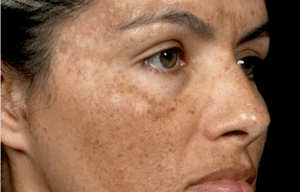Melasma vs Freckles
If you’ve ever looked in the mirror and wondered whether those brown spots on your face are melasma or freckles, you’re not alone. Both are forms of hyperpigmentation, but they come from very different causes and require completely different treatments. Misdiagnosing one for the other can lead to frustration, wasted money, and even worsening of the condition.
What Are Freckles?
Freckles, known medically as ephelides, are small, flat brown spots that usually appear on sun-exposed areas of the skin—most commonly the face, shoulders, and arms. They’re more common in people with fair skin and red or blonde hair, and they tend to show up in childhood or adolescence.

Etiology: Freckles are caused by an increase in melanin production, not an increase in the number of melanocytes (the cells that produce pigment). UV radiation from sun exposure triggers melanin production, which is why freckles often darken in the summer and fade in the winter.
There’s also a strong genetic component to freckles. Variants in the MC1R gene are associated with red hair, fair skin, and increased freckling. One study published in Human Molecular Genetics found that individuals with certain MC1R variants were significantly more likely to have freckles.
Key Characteristics of Freckles:
Small (usually less than 5 mm in diameter)
Light to dark brown
Symmetrical and evenly pigmented
More prominent with sun exposure
Usually fade in the absence of sun
Common in people with Fitzpatrick skin types I and II
What Is Melasma?
Melasma is a more complex form of hyperpigmentation that appears as larger, irregularly shaped patches of brown or gray-brown skin. It often affects the cheeks, forehead, upper lip, and chin and is much more common in women—especially during or after pregnancy, while on birth control, or while taking hormone replacement therapy.

Etiology: Melasma is believed to be caused by a combination of hormonal influences and UV exposure. It’s also associated with heat and visible light. Unlike freckles, melasma involves both increased melanin production and increased melanocyte activity. This makes it deeper and harder to treat.
Key Characteristics of Melasma:
Larger, irregular patches of pigment
Symmetrical (often appearing in a “mask-like” distribution)
Doesn’t fade as easily with sun avoidance
Triggered or worsened by hormones, heat, and UV exposure
More common in women and individuals with darker skin types (Fitzpatrick III–VI)
Melasma vs Freckles: How to Tell the Difference
While freckles and melasma may look similar at first glance, there are some important clues that can help you (and your dermatologist or facial plastic surgeon) distinguish between them:
| Feature | Freckles | Melasma |
|---|---|---|
| Size | Small (1–5 mm) | Larger patches |
| Shape | Round or oval | Irregular, geographic shapes |
| Symmetry | Random distribution | Symmetrical, often bilateral |
| Seasonality | Darken in summer, fade in winter | Persist year-round, often worsen with sun and heat |
| Location | Sun-exposed areas like nose and cheeks | Forehead, cheeks, upper lip, jawline |
| Triggers | UV light | UV light, hormones, heat, pregnancy |
If you’re still not sure, your provider may use a Wood’s lamp or skin analysis imaging to evaluate the depth and distribution of pigment.
Why the Right Diagnosis Matters
Here’s the problem: treatments that work for freckles can actually make melasma worse—and vice versa. That’s why it’s so important to get the right diagnosis before starting any pigmentation treatment.
Treating Freckles
Since freckles are superficial and respond well to targeted treatments, they’re often easier to treat than melasma. But many people choose to keep their freckles—they’re seen as a youthful and natural feature by some. If you do want to lighten or remove freckles, here are your best options:
1. Sun Protection
This is step one for any pigmentation issue. Daily sunscreen with SPF 30 or higher (and broad-spectrum protection against UVA/UVB) will prevent new freckles and stop existing ones from getting darker.
2. Topical Lightening Agents
Ingredients like vitamin C, niacinamide, retinol, and hydroquinone can help lighten freckles over time. These work by decreasing melanin production and encouraging cell turnover.
3. Laser Treatments
Freckles usually respond well to laser and light therapies like:
Intense Pulsed Light (IPL) or Broad Band Light (BBL)
Q-switched lasers
Pico lasers These treatments target melanin in the superficial layers of skin and can break up the pigment with little downtime. But remember—without sun protection, the freckles can return quickly.
4. Chemical Peels
Superficial chemical peels like glycolic acid or TCA can help remove pigmented cells and brighten the skin. These are best used under professional supervision.
Treating Melasma
Melasma is much more stubborn—and if you treat it like freckles, you might actually make it worse. For example, aggressive lasers or heat-based treatments can inflame the skin and stimulate more pigment production.
1. Rigorous Sun Protection
Daily use of mineral sunscreen with iron oxide (which protects against visible light) is non-negotiable. Physical blockers like zinc oxide and titanium dioxide are preferred.
2. Topical Therapies
Melasma often requires a multi-pronged approach with ingredients that address different stages of pigment formation. Some of the most effective include:
Hydroquinone (short-term use)
Tranexamic acid (oral or topical)
Cysteamine
Azelaic acid
Retinoids
Skinbetter Even Tone Correcting Serum or Cyspera
3. Oral Medications
Low-dose oral tranexamic acid has shown promise in reducing melasma in stubborn cases, especially when used in conjunction with topicals.
4. Gentle Laser and Light Treatments
Lasers are tricky with melasma. Some devices, like low-fluence Q-switched lasers or fractionated non-ablative lasers (like Clear + Brilliant or Moxi), can help—but only under expert care. RF microneedling with insulated needles, like Morpheus8, can also be used cautiously.
5. Chemical Peels
Mild chemical peels like mandelic or lactic acid can improve melasma when used in series, but they should be paired with appropriate topical care.
6. Patience and Maintenance
Melasma isn’t “cured”—it’s managed. Ongoing skincare, sun protection, and seasonal adjustments are needed to keep it in check.
Common Pitfalls in Treating Pigmentation
Mistaking melasma for freckles can lead to:
Use of harsh lasers that worsen pigmentation
Frustration from lack of results
Risk of post-inflammatory hyperpigmentation (especially in darker skin tones)
Mistaking freckles for melasma may result in:
Overly cautious treatments that don’t yield visible improvement
Unnecessary use of systemic medications
Prolonged treatment timelines
Get the Best Treatment for Your Skin Concerns
When it comes to melasma vs freckles, knowledge is power. Understanding what you’re dealing with can save you time, money, and stress—not to mention your skin. While freckles are often harmless and even endearing, melasma can be a stubborn sign of underlying hormonal and environmental triggers. Knowing the difference helps you choose the right treatment path and avoid common mistakes.
So next time you’re squinting at those brown spots in the mirror, remember: it’s not just about what you see—it’s about what’s going on beneath the surface. And the more you know, the better you can glow.
Ready to get expert help with your pigmentation concerns? Contact our office for a consultation and personalized treatment plan. Whether it’s melasma or freckles, we’re here to help you reveal your clearest, healthiest skin yet.
You May Also Like: